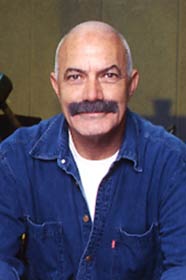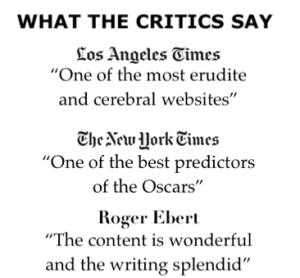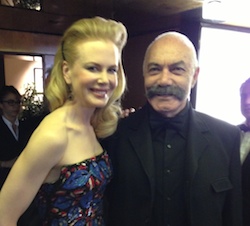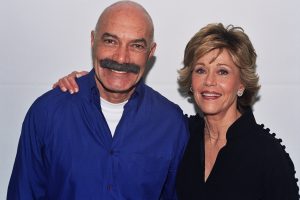Dennis Hopper and Bruno Ganz deliver superb, complementary performances in Wim Wenders’ The American Friend, a gripping Hitchcockian thriller based on Patricia Highsmith’s novel.
Grade: A- (**** out of *****)
| The American Friend (Der amerikanische Freund) |
|
|---|---|

German film poster
|
|
Swiss-based Ganz (best-known for his German films) plays Jonathan Zimmermann, a Hamburg picture-frame and painting restorer who’s suffering from an incurable blood disease. When he meets Tom Ripley (Hopper), a shady American who sells forged paintings in Germany, he’s surprised to realize that Ripley knows about his illness.
As a result of a perceived slight when the two men are introduced, Ripley spreads the rumor that Jonathan’s death is imminent and suggests his name to a criminal associate named Minot (Gerard Blain), who’s looking for a non-professional hit man to dispose of his rivals.
At first, Jonathan refuses, but he changes his mind when his anxiety over his terminal condition worsens. Jonathan carries out Minot’s assignment, which involves shooting a man in a Paris subway. Back in Germany, Minot pays him only half of the promised fee, but promises to pay the remainder after Jonathan performs another mission.
Both moody and intriguing, “The American Friend” is effective as a thriller and existential character study. The movie pays homage to the American cinema not only in its casting of Wim Wenders’ two cult heroes, directors Nicholas Ray (Rebel Without a Cause) and Samuel Fuller, but also in its thematic and stylistic references to other cult directors, such as Hitchcock and “Strangers on a Train,” which is also based on a Patricia Highsmith’s novel.
“What’s wrong with a cowboy in Hamburg” asks the Stetson-clad Dennis Hopper. Plenty, according to Wenders, who would go on to make the sublime modern Western, “Paris, Texas.” In contemporary German, however, Ripley, a drifting American criminal, seems a rather pathetic cowboy. The devilish Ripley drives around town while spouting his philosophy into a tape recorder (a favorite device for Wenders). Though emasculated, helpless, and confused, he nonetheless finds the resources and energy to warm his way into Zimmermann’s life, dividing in the process his beloved family.
It’s noteworthy, that Zimmermann speaks German with his family and his doctor, but English with Ripley and while visiting Paris.
Wenders’ fascination with Hollywood is evident in the murky, gangster-like plot and the numerous references to Hitchcock and other directors. But there’s a bitter, more existential undercurrent to the allusions. Several critics have suggested that the movie is really an allegory bout the corrupting influence of the American (and Hollywood specifically) presence abroad. Indeed, Wenders treats the story as an ironic commentary on the irreversible impact of American pop culture on Germany, and the uneasy relationship between the two countries and their respective national cultures.
The film, like most of Wenders’ work, is also a personal meditation on the acts of seeing and looking. Wenders handles the thriller aspects of his saga expertly in what is easily one of his most accessible and enjoyable pictures.
It’s a richly textured, deeply rewarding film that benefits from the moody photography of Robby Muller and from the superb acting of the two leads, with each brilliantly playing off the other’s differing style.
Credits
Produced, written, directed by Wim Wenders
Based on Ripley’s Game by Patricia Highsmith
Music by Jürgen Knieper
Cinematography Robby Müller
Edited by Peter Przygodda
Distributed by Filmverlag der Autoren
Release date: March 26, 1977 (Cannes); June 24, 1977 (Berlin)
Running time: 127 minutes



